| Travel Photos Home Page |
HONG KONG 2018
|
||||
|
To return to the Paintings section of this website, please CLICK HERE
|
|||
| In January and February 2018, I visited Hong Kong for about 12 days.
I was born in Hong Kong, way back in 1937, and I left for Australia in 1953. Since then, I have returned for brief visits on several occasions. My Travel Photos Home Page has links to other pages of photos from those previous visits. To reach the Travel Photos Home Page, please click on the link above. This time I decided to skip the usual tourist hot spots (like the Big Buddha on Lan Tau Island) and get in touch with my Inner Boy Scout and explore some of the less well known parts of Hong Kong. |
|||
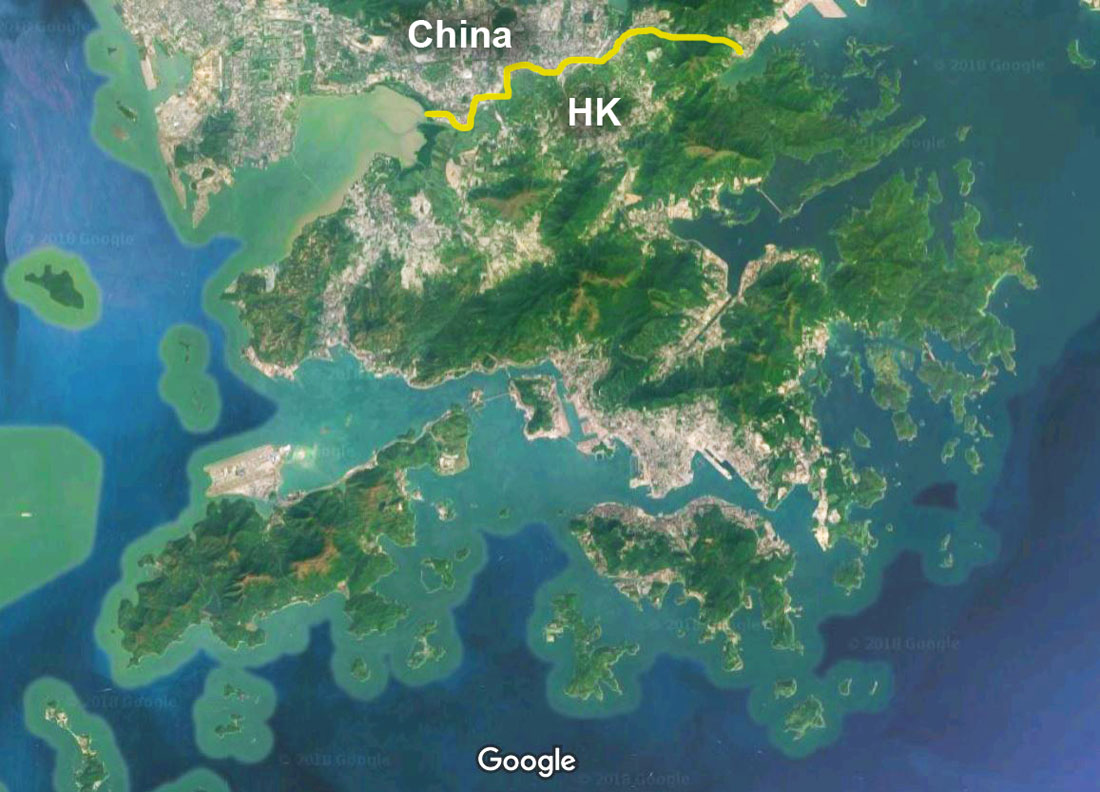 |
|||||
| Hong Kong has historically been a refuge for all those who have fled the Chinese mainland during times of crisis. Today the population of Hong Kong is a bit over 7.3 million. I remember what happened when the Communist Party first came to power in 1949. There was a huge influx of refugees and there was no where for them to live in that small British Colony. The refugees quickly built shanty towns on the hills of Kowloon and Hong Kong. These squatter huts were made of flimsy materials like tin and cardboard. Conditions in those squatter huts were abominable.
The Hong Kong authorities realised that the only way to solve this housing crisis was to start building high rise apartment blocks. Much of Hong Kong is hilly, so that spurred the old practice of land reclamation from the harbour and bays in the New Territories. Land relamation was practised right from the start of the Colonial Period so it was not new, but the scale and speed of reclamation was hugely increased, partly thanks to technological advances since the early years of the Colony. |
What is interesting is that past Governors of Hong Kong had the foresight to declare large tracts of land as "Country Parks". These Parks provide great opportunities for those who enjoy hiking in the wilderness, but one practical reason is that they provided clean, green areas which could provide good water catchment for the new reservoirs which had to be built to ensure fresh water security. This was especially pertinent as there was considerable tension between the new Communist Government in Beijing and the British authorities in Hong Kong. The colony had been very dependant on water supplies from the Chinese mainland.
If you have a close look at the Google Satellite map of Hong Kong above, you can see that much of the land surface is green forest. Most of the population live in giant blocks of apartment buildings, many of which have been built on reclaimed land. |
||||
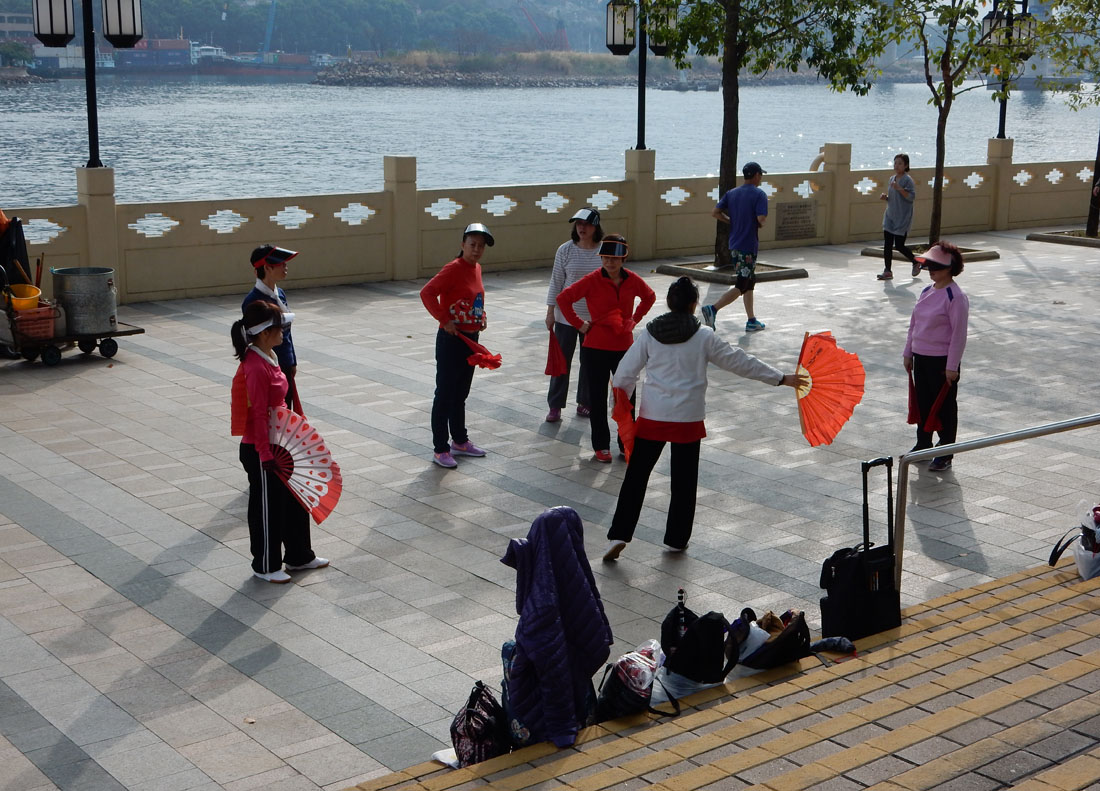 |
|||
| The locals are very keen on exercise to keep fit. Here is a group of women practising a fan routine on the island of Tsing Yi. Tsing Yi is an island in Hong Kong Harbour and, if you have ever travelled to the new airport, you will have passed over Tsing Yi by bridge or tunnel.
Part of Tsing Yi is now a container terminal, and it also has an array of apartment buildings, but care has been taken to provide plenty of open spaces and harbourside promenades to give the residents recreational spaces. |
|||
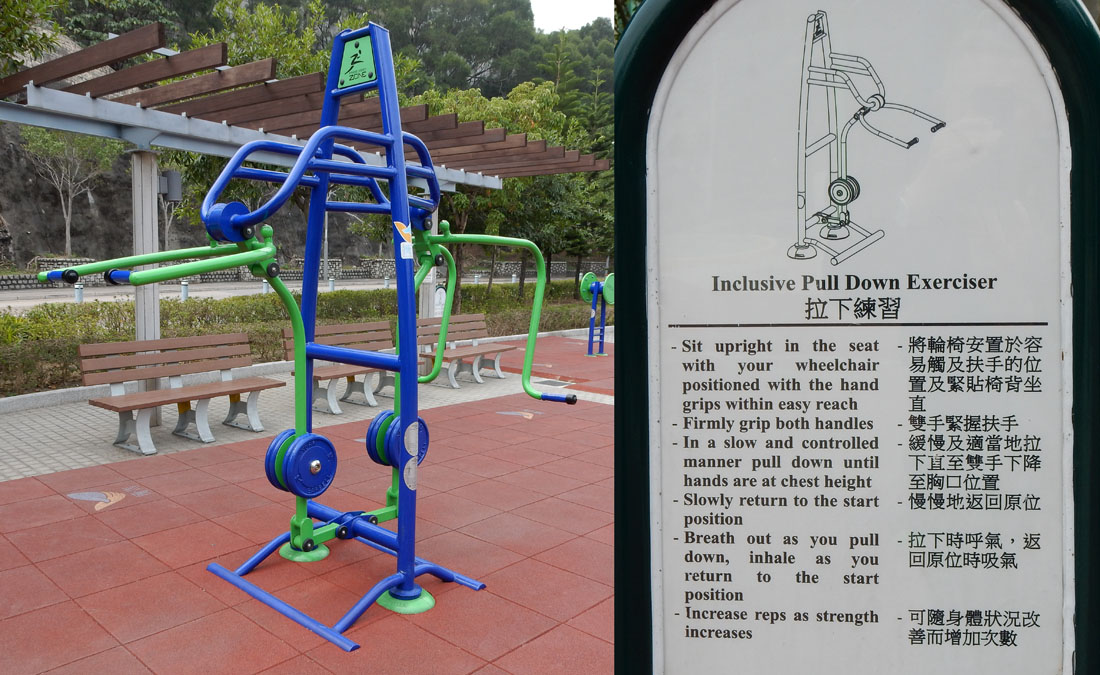 |
|||
| As an 80 year old traveller, I do appreciate that the Hong Kong authorities are especially keen to keep their elderly citizens fit and healthy! There are lots of special facilities for the elderly. I particularly liked this BYOW pulldown exerciser (Bring Your Own Wheelchair) on Tsing Yi. | |||
 |
|||
| This Senior Citizen was enjoying his Harbour swim just off Tsing Yi Island. It was freezing cold when I was there in January so I hope he wore suitable protective clothing. | |||
 |
|||
| A view of the Harbour Waterside Promenade on Tsing Yi Island. Note the birdcage hanging in the tree on the right of the photo! | |||
 |
|||||
| This is a swish riverside park in Tuen Mun, which is at the far Western end of the New Territories. Tuen Mun is yet another area filled with giant apartmanet blocks. It is connected to Downtown Kowloon with an MTR line as well as buses which travel along the Hong Kong Gold Coast roads. There is also an extensive light rail system in this part of the New Territories. | I mentioned earlier that Hong Kong is kind to its elderly. That kindness extends to foreigners as well. If or when you get to Hong Kong, and if your age is appropriate, make sure to ask for a Seniors Octopus Pass. With that pass, almost all individual journeys by rail, tram, ferry or bus will cost you no more that HK$2. That is about 25 US cents or about 33 Aussie cents. Public transport in Hong Kong is very efficient and reliable. For a fun ride, go upstairs in a double decker bus and sit right up at the front. It is a great way to see the sights! | ||||
 |
|||
| Many of the new Housing Estates commission local artists and craftsmen to make suitable decorations for their public spaces. These two Jelly Fish characters are in Ma On Shan, near Shatin in the New Territories. | |||
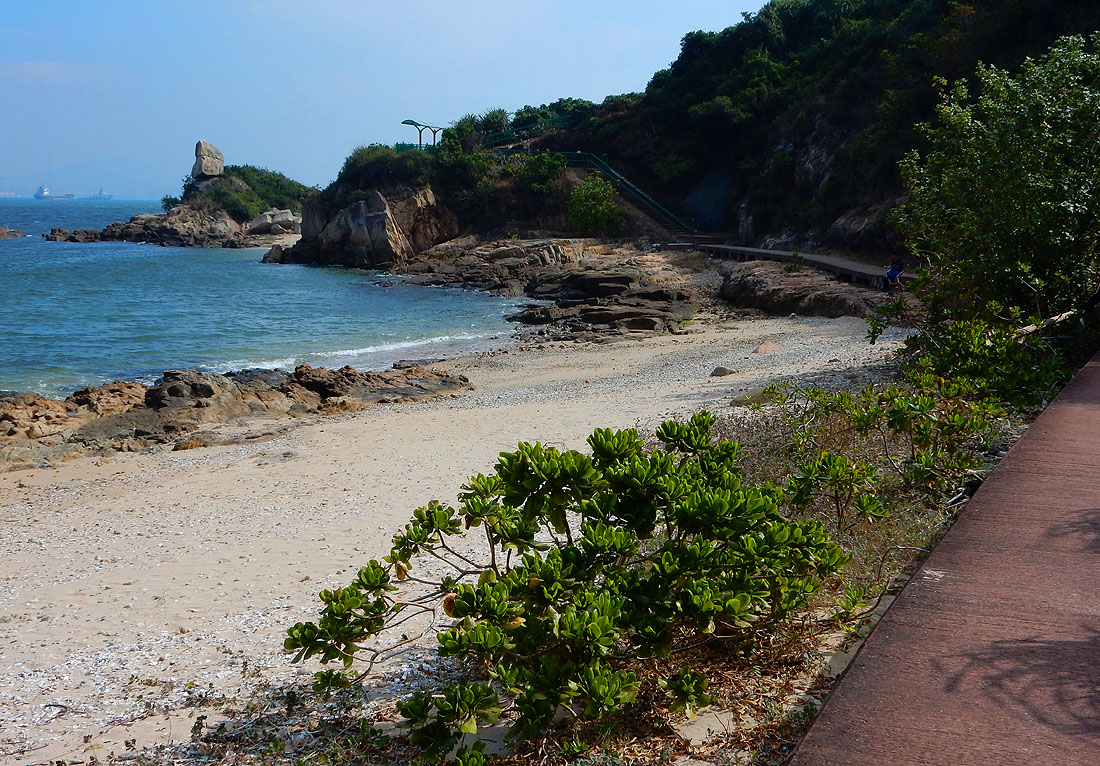 |
|||
| This beach and headland are on the island of Peng Chau. It is a small(ish) island just off the coast of Lan Tau. It is remarkably easy to travel between some of the smaller islands of Hong Kong using the Inter-Island ferry service.
It was very pleasant walking around this island on well-maintained paths. |
|||
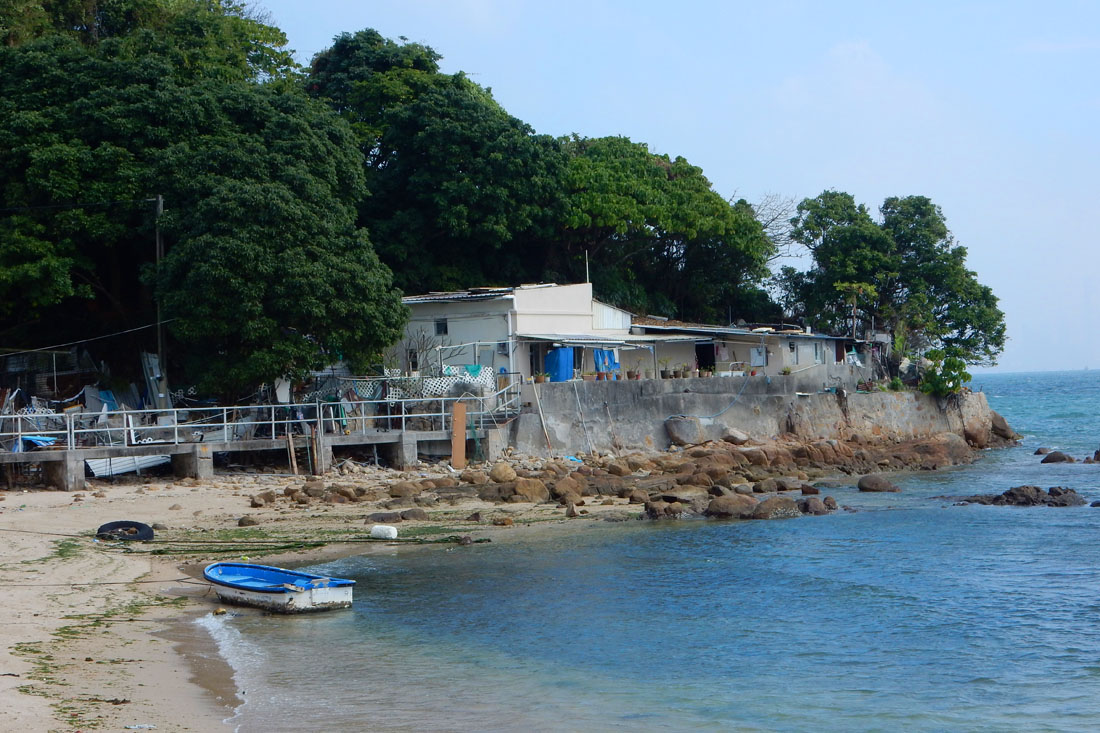 |
|||
| On Peng Chau Island. | |||
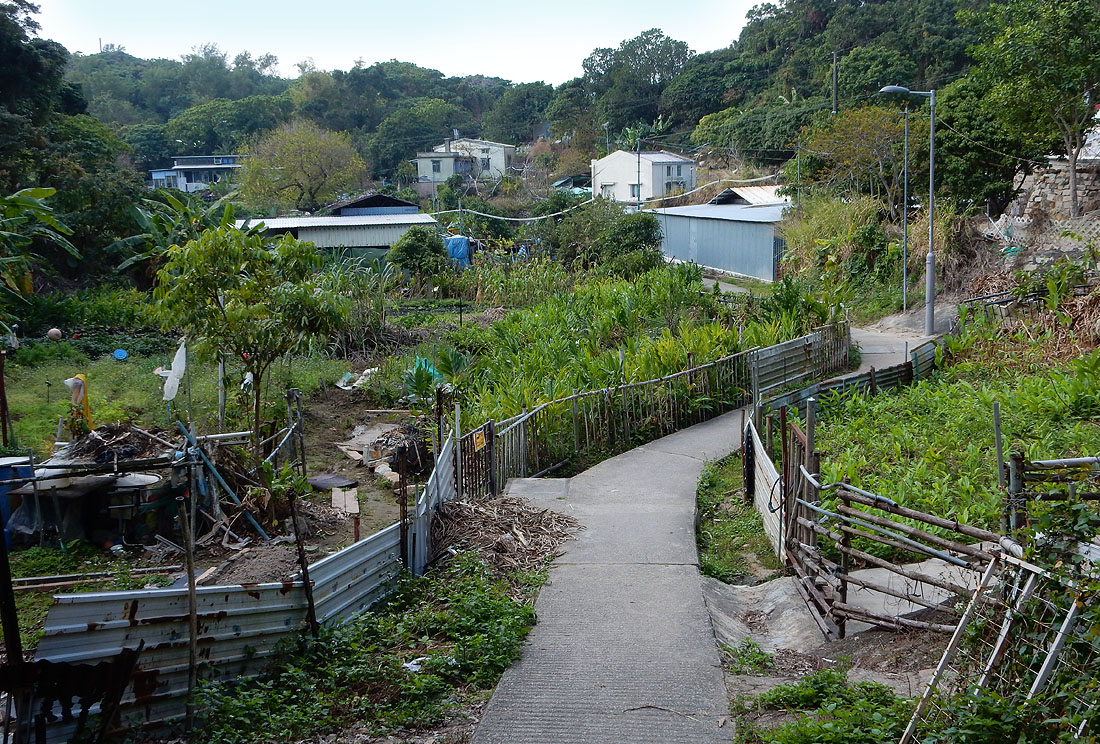 |
|||
| Cutting through the middle of Peng Chau I came across this little village with an assortment of crops growing in their fields. | |||
 |
|||
| I took this photo on the ferry from Peng Chau to Cheung Chau Island. The ferry stopped en route at Mui Wo. As a Boy Scout, back in the 1940s and early 50s, I often camped at Mui Wo, close to the beach at Silvermine Bay.
The white building with the cross in the photo is a Trappist Monastery, called "Our Lady of Joy Abbey". It is on the cross country path between Discovery Bay and Mui Wo. Lan Tau Island, like the rest of Hong Kong, has an extensive network of Country Park trails. |
|||
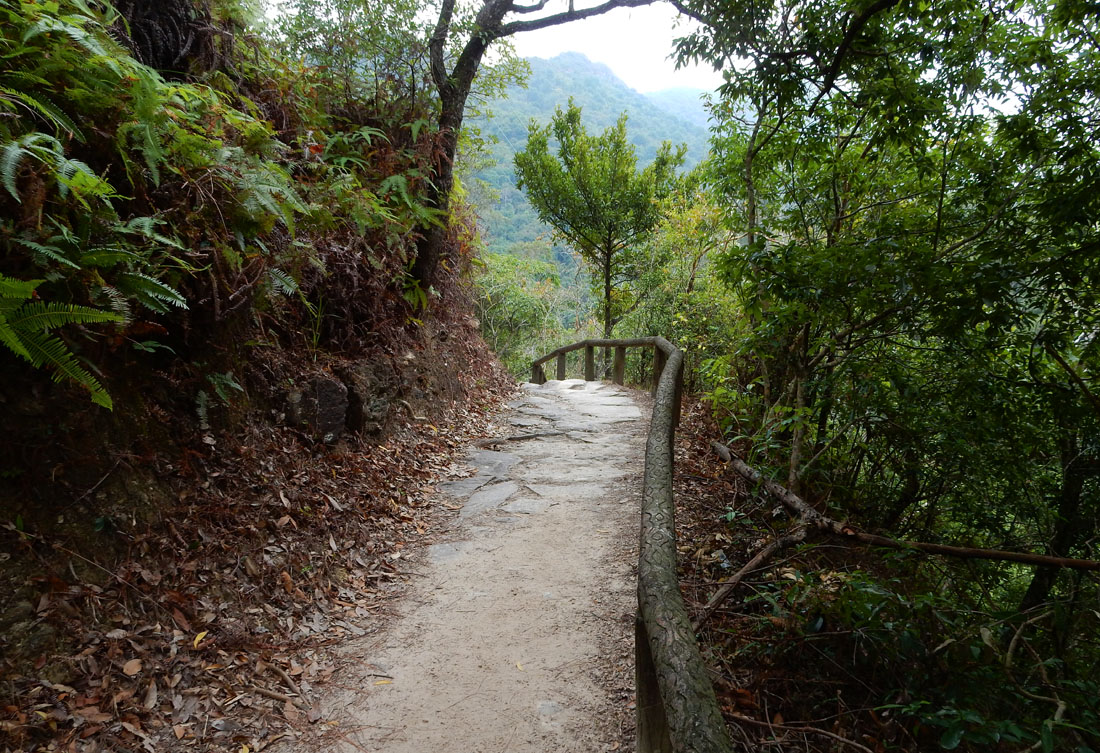 |
|||
| In the North Eastern corner of the New Territories, we find the Plover Cove Country Park. This path took me to the Bride's Pool. | |||
 |
|||
| Although it was quite cold when I was in HK, it was also mostly dry so the waterfall at the Bride's Pool was just a trickle. However, this area can be dangerous as huge volumes of water can pour swiftly down from the hills when it rains heavily.
It is called the Bride's Pool because of the legend that recounts how a bride on her way to her wedding, slipped and fell into the pool in her heavy bridal outfit and drowned. Naturally, the Chinese instantly turned this into a Ghost Story. The Chinese LOVE ghost stories! |
|||
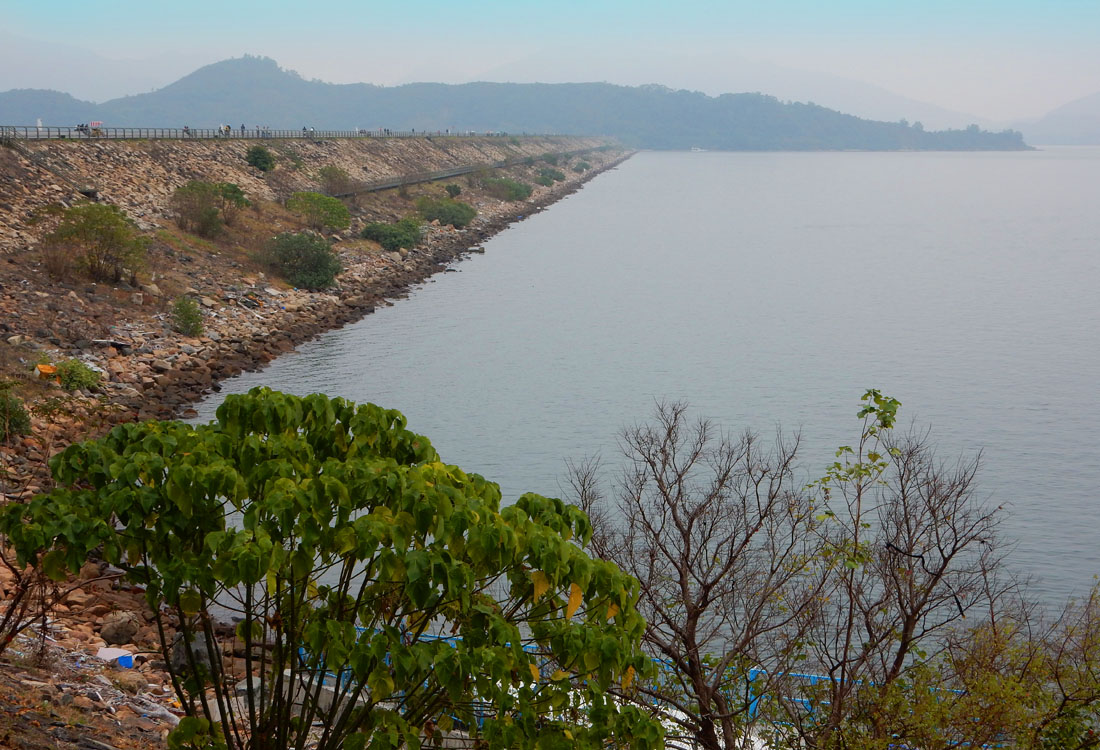 |
|||
| This dam is a remarkable piece of engineering. Plover Cove was a very large bay filled with sea water. The dam was constructed, the salt water pumped away and fresh water began collecting in the newly built reservoir. A plaque at the site states that the "Plover Cove Water Scheme" was inaugurated on the 20th January, 1969 by His Excellency The Governor Sir David Trench GC MG MC. The catchment area for this reserovir is called the Plover Cove Country Park. | |||
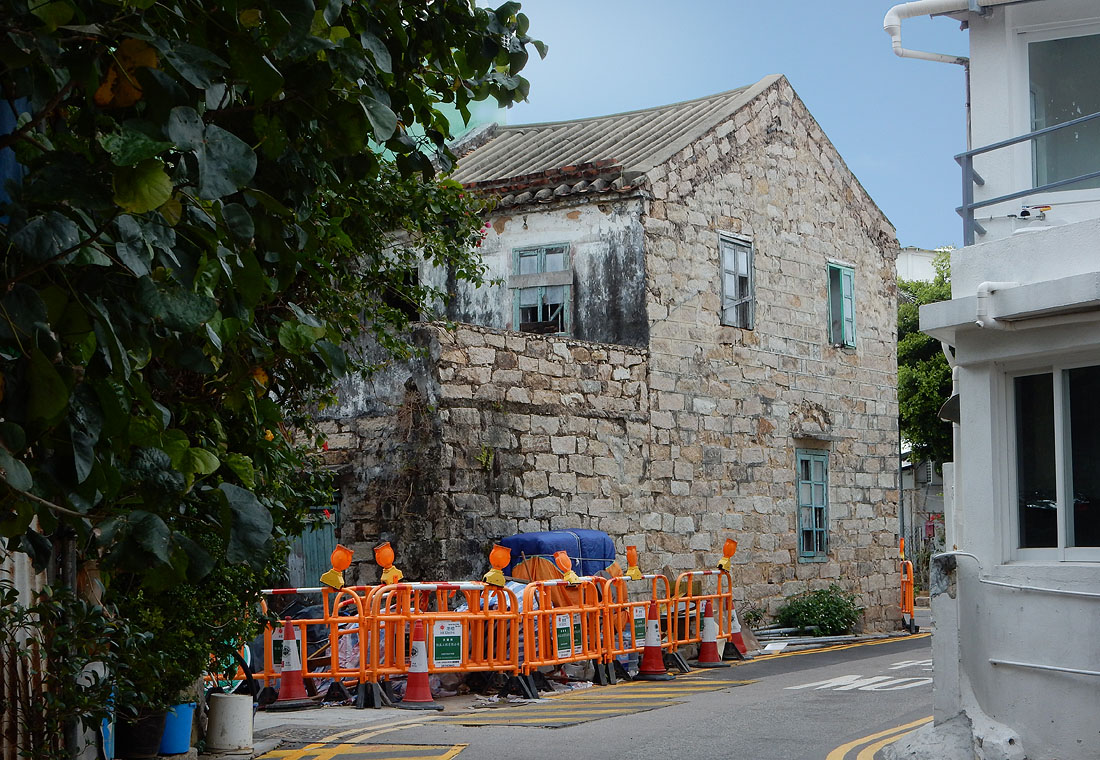 |
|||
| Buildings in Hong Kong ususally don't last long. They are knocked down and replaced by something new fairly regularly. So if you want some immortality, make sure that you have a street or road in Hong Kong named after you. They tend to stay much the same no matter what happens politically.
I happened to see this old stone house in Shek O. I just hope that it will be restored to its former glory! |
|||
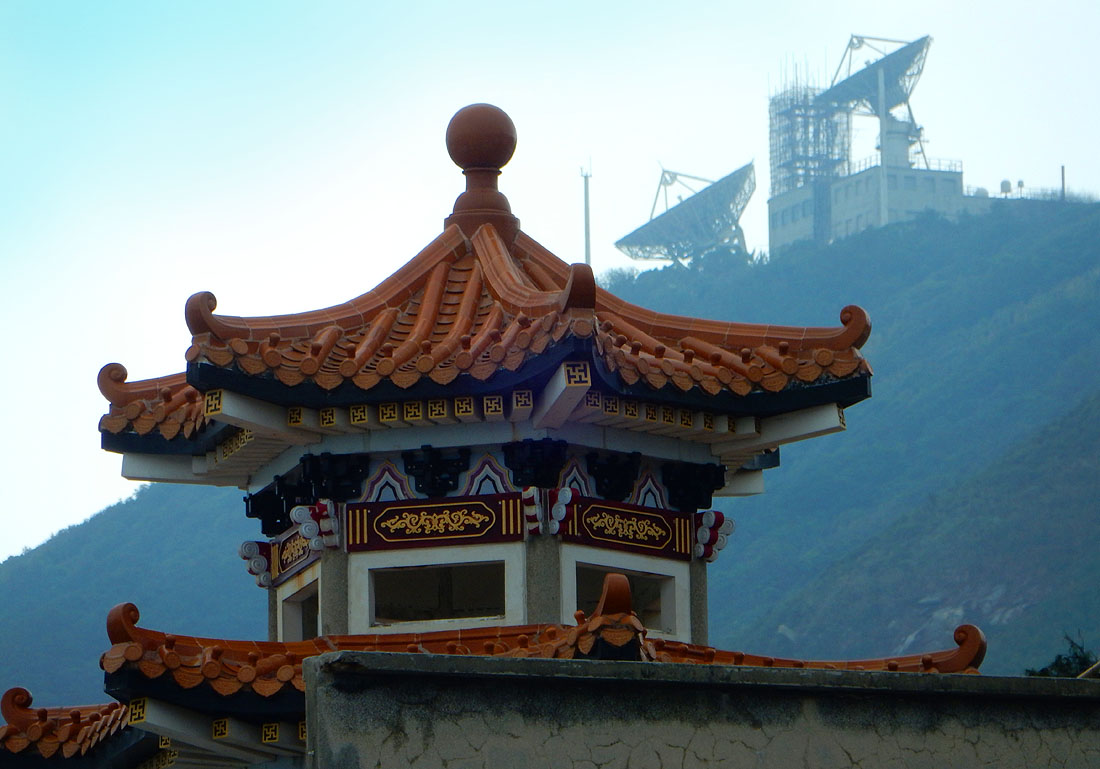 |
|||
| Also in Shek O, this contrast between the old and the new caught my eye. | |||
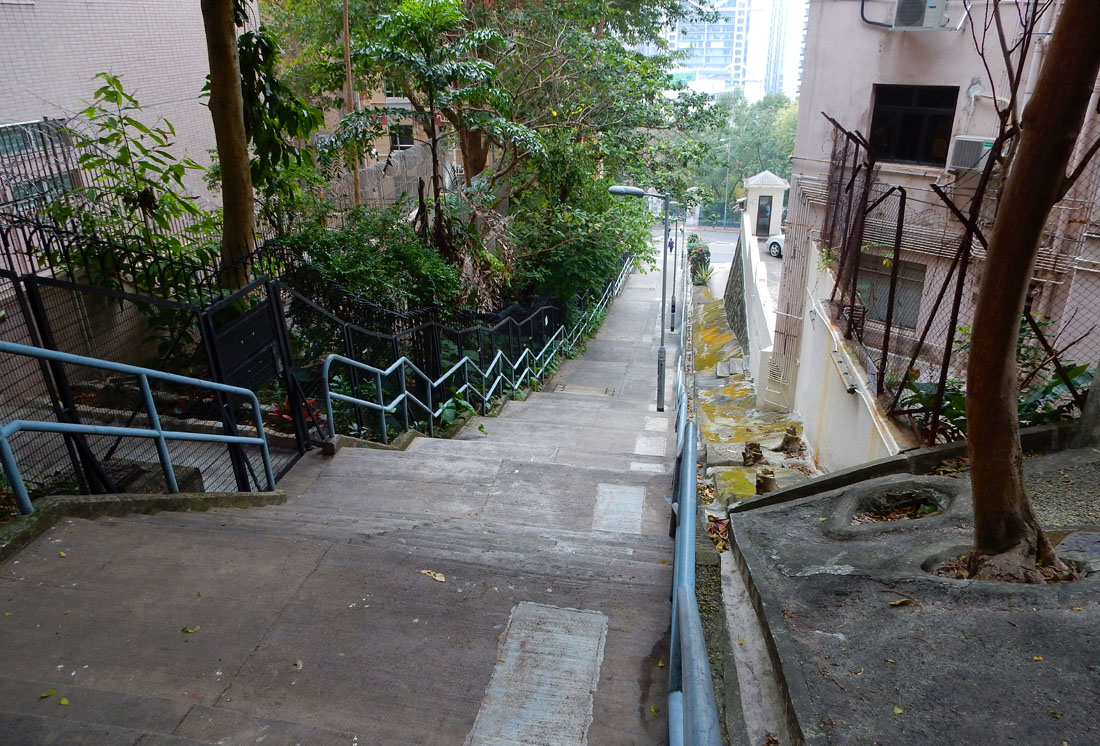 |
|||
| This path from Bowen Road to the Peak Tram Terminus brought back memories of the times when I would skip down these steps on my way to King George V School in Kowloon. Looking back, I am amused by the fact that I was doing this trip daily on my own when I was just 9 years old. We kids in Honkers were never wrapped in cotton wool.
For kids, Hong Kong was remarkably safe. I was both a Catholic altar boy and a British Boy Scout and I was never sexually abused. Mind you, I was a very ugly child! |
|||
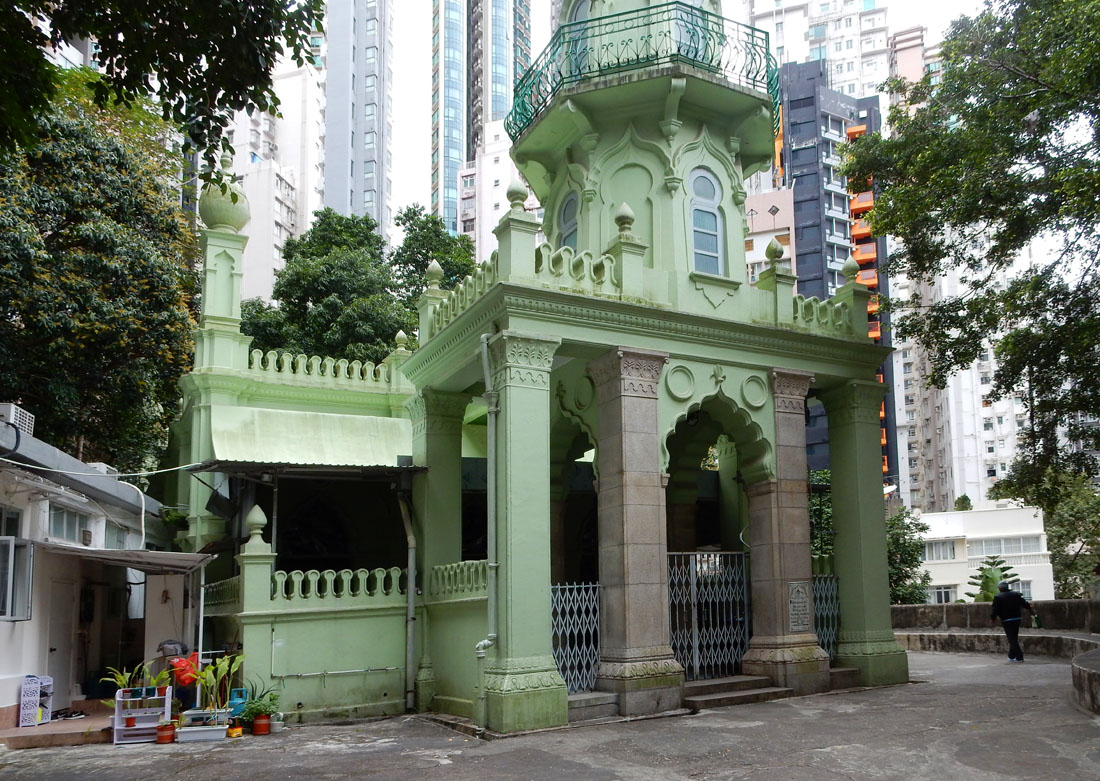 |
|||
| Religion plays a large part in the lives of the people here. This Islamic Mosque was, in a way, part of my life in Hong Kong during World War Two. It was right next door to the Italian Convent on Caine Road where my family and I lived for the last couple of years of the Japanese Occupation.
I was the only Catholic in the family as the others were all Russian Orthodox, but the Catholic Church gave all of us permission to gain refuge in the Convent. My father was the first man ever given the right to live in this Matriarchal community. Those were desperate times. The Mosque in the photo above was right next to the window of the single room we occupied. There were no loudspeakers then and the voice of the Muezzin calling his faithful to prayer was sweet and soothing. There is a plaque stating that the Mosque was rebuilt by H M H Essack Elias of Bombay in 15th August, 1915. |
|||
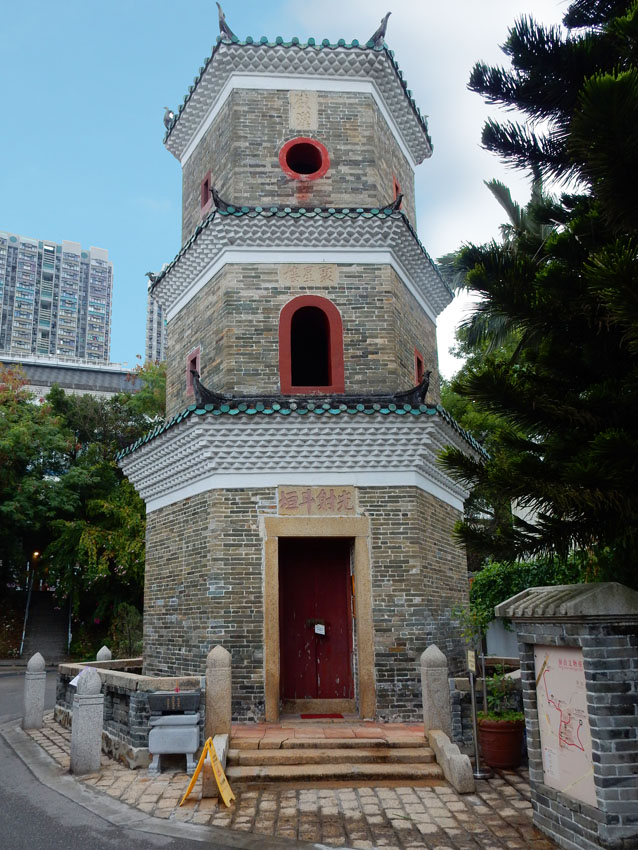 |
||||
| This is the old Tsui Sing Lau Pagoda which is part of the Ping Shan Heritage Trail.
Ping Shan is in the North Western corner of the New Territories and it is probably the first part of Hong Kong to have been settled ages ago. Unlike much of the topography of Hong Kong and its islands and territories, Ping Shan, Yuen Long and Tin Shui Wai are on relatively flat land, ideally suited to agriculture. According to legend, this Pagoda was built by Tang Yin-tung more that 600 years ago and it may have originally been a seven storey structure. |
||||
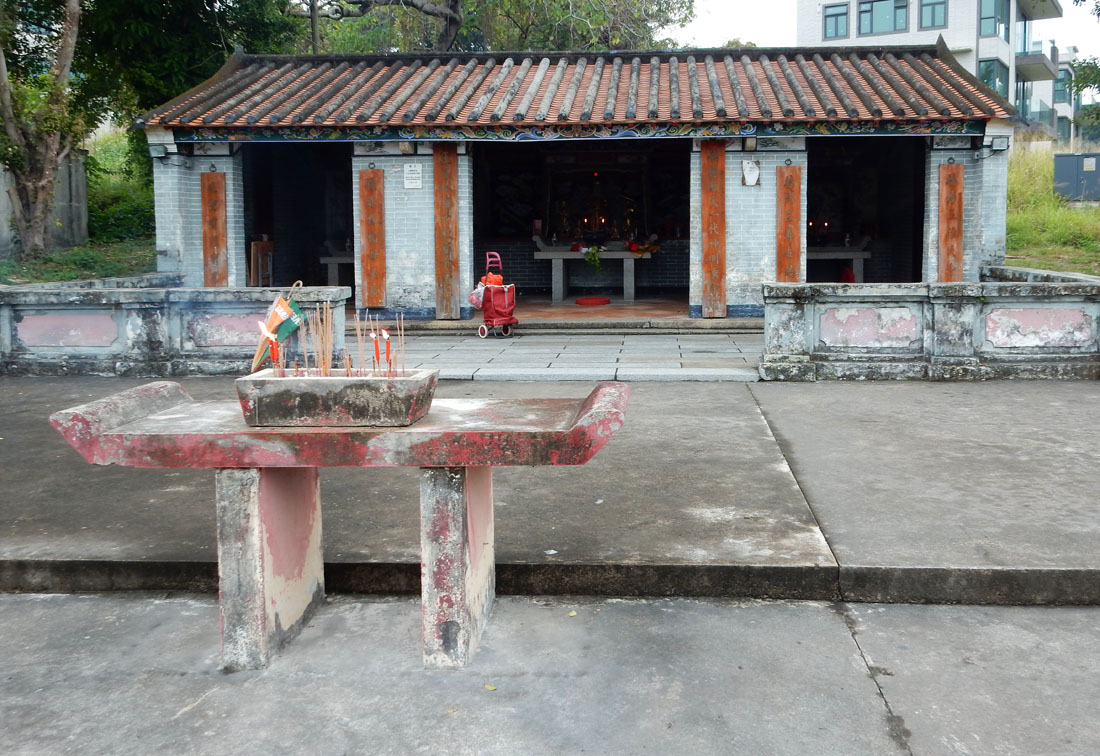 |
|||
| This is the Shrine of the Earth God, the protector of villages, on the Heritage Trail. | |||
 |
|||
| This was the entrance to Sheung Cheung Wai, the Ping Shan Tang Clan's walled village. It could be easily defended against attacks by pirates or other criminals. | |||
 |
|||
| This is the interior courtyard of the Tang Ancestral Hall. | |||
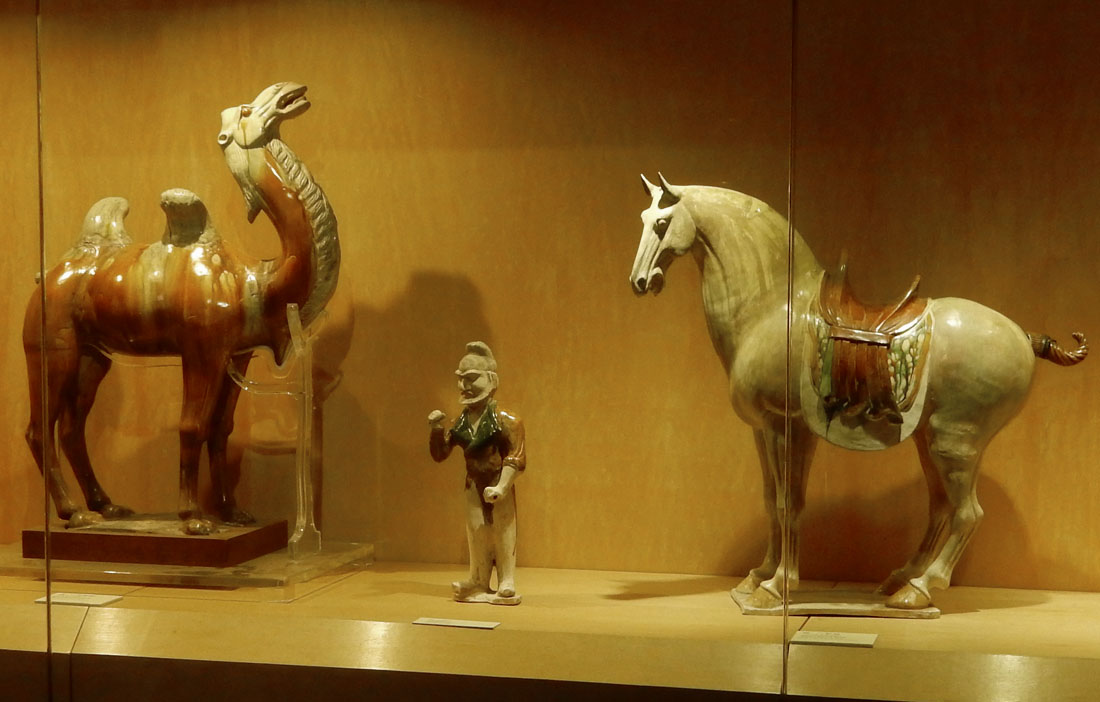 |
|||
| On the one day in which it rained while I was in Hong Kong, I decided to visit a Museum. I chose the University Museum and Art Gallery of the University of Hong Kong.
The photo above is of figures of a camel, a horse and a groom from the Tang Dynasty (618 - 907 AD) |
|||
 |
|||
| Painted pottery horse. Han dynasty (206 BC - 220 AD) | |||
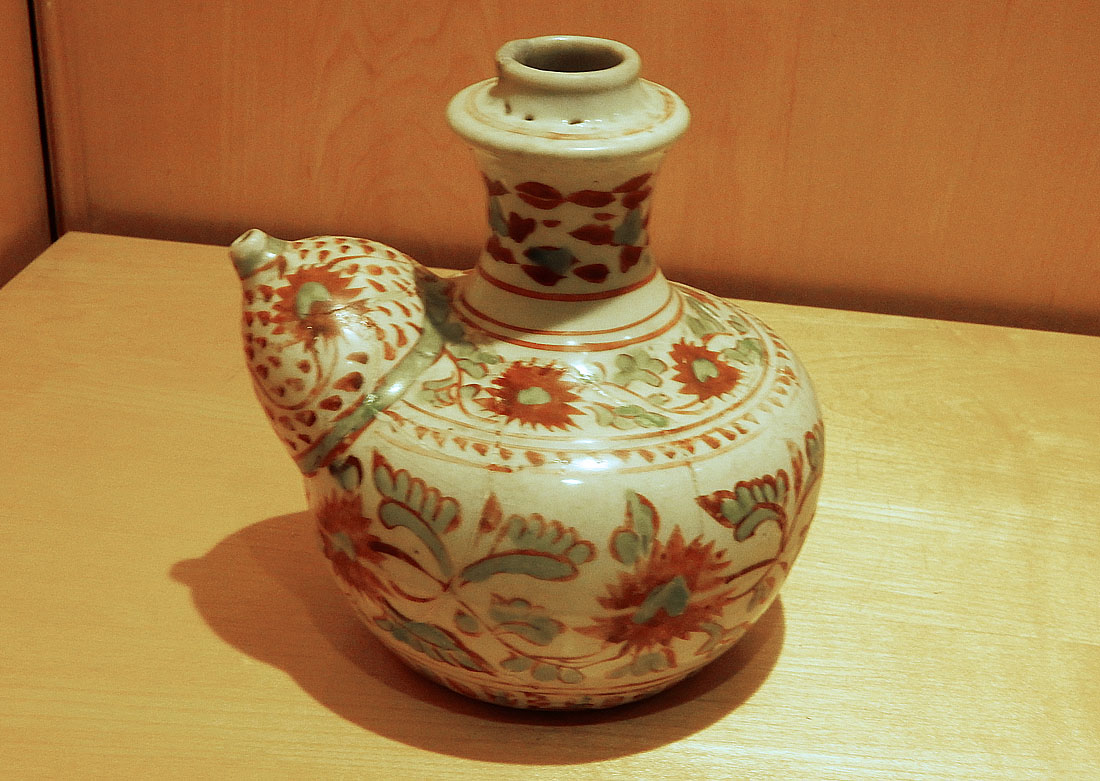 |
|||
| Kendi. Late Ming Dynasty, 16th or 17th Century.
Kendi is a word from the Malay or from Sanskrit. It is a type of pot which has a spout which can be used for pouring liquid or for drinking directly from the container. It was used for cermonial purposes throughout Asia. |
|||
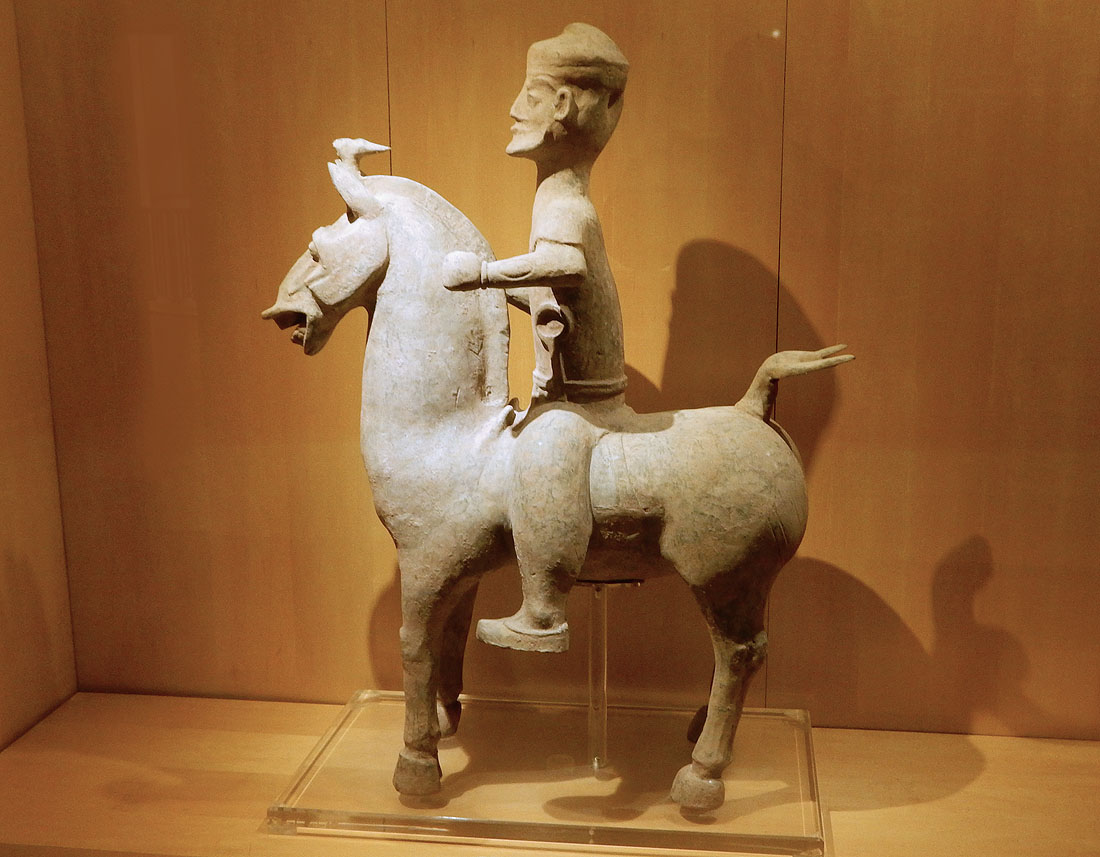 |
|||
| Painted pottery figure of horse and rider. Han Dynasty (206 BC - 220 AD) | |||
 |
|||
| This piece at the Museum at HKU is a "green-glazed funerary jar with applique design of figures". It is from the Three Kingdoms period (220 - 265 AD). | |||
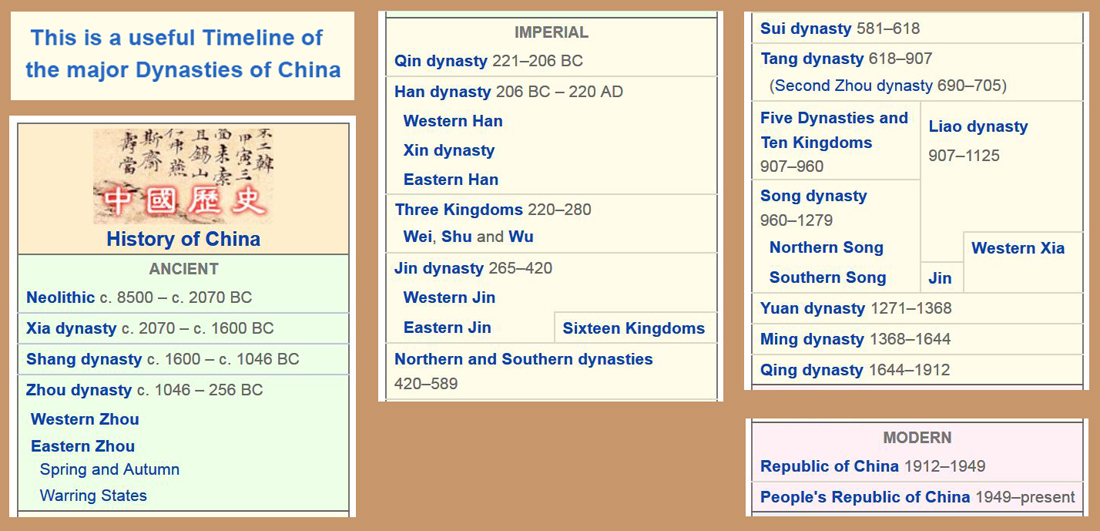 |
|||
| I wanted to give an attribution to this list of Chinese Dynasties, but for the life of me I can't find the source. If anybody knows where this came from, please get in touch with me. Thanks in anticipation. | |||
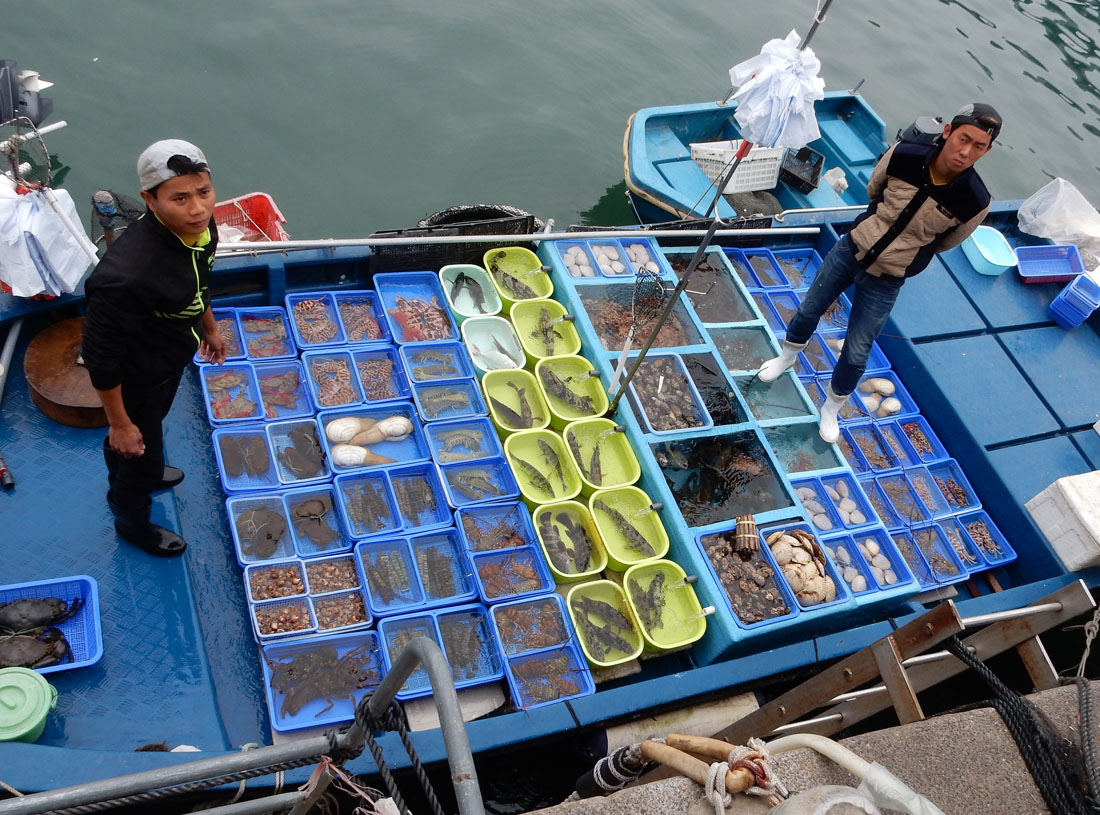 |
|||
| In Sai Kung, you can buy your fresh fish right from the boat. | |||
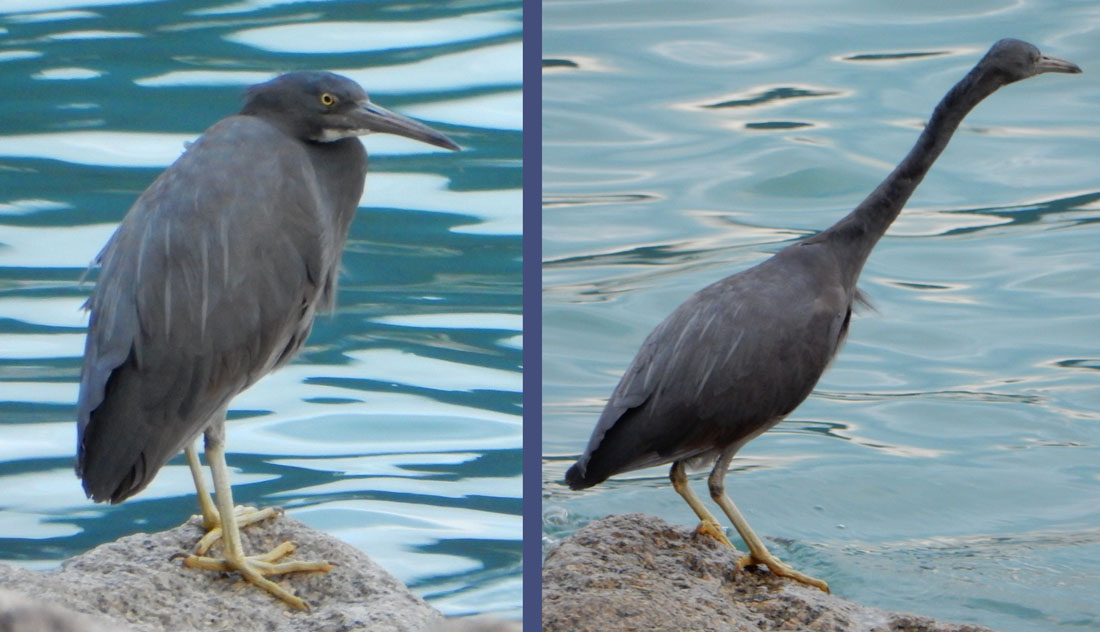 |
|||
| This is the very same waterbird in both photos. Neck in... neck OUT! | |||
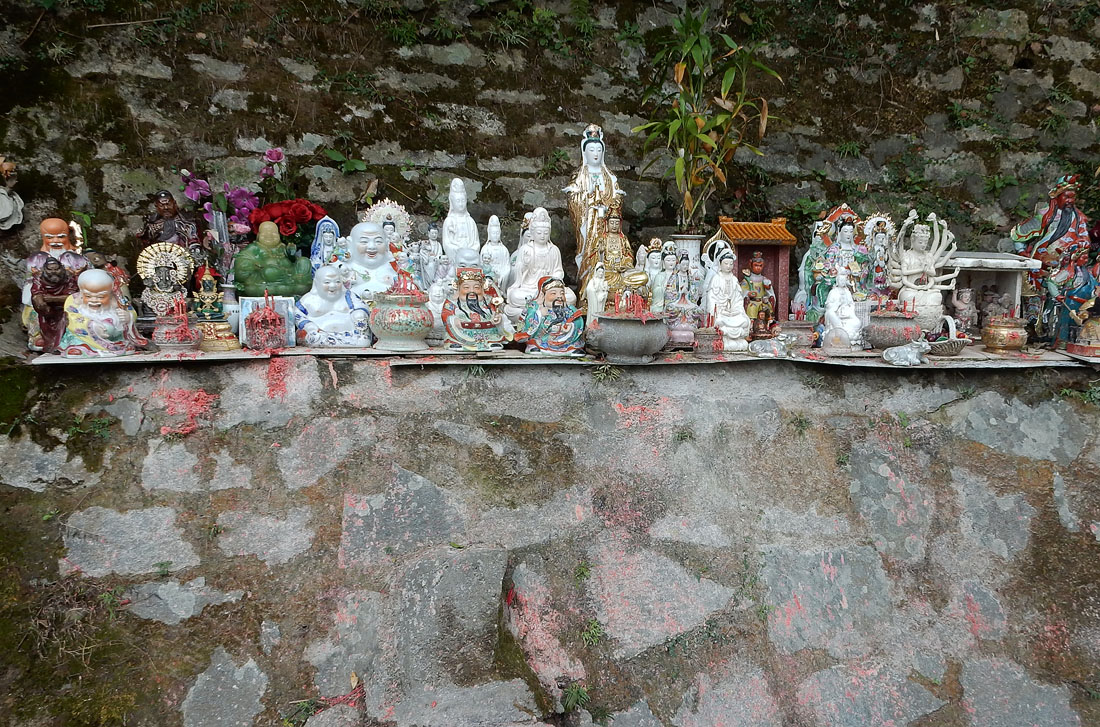 |
|||
| Still in Sai Kung, I came across this local shrine kept alive by the locals. Such shrines pop up everywhere in Hong Kong. | |||
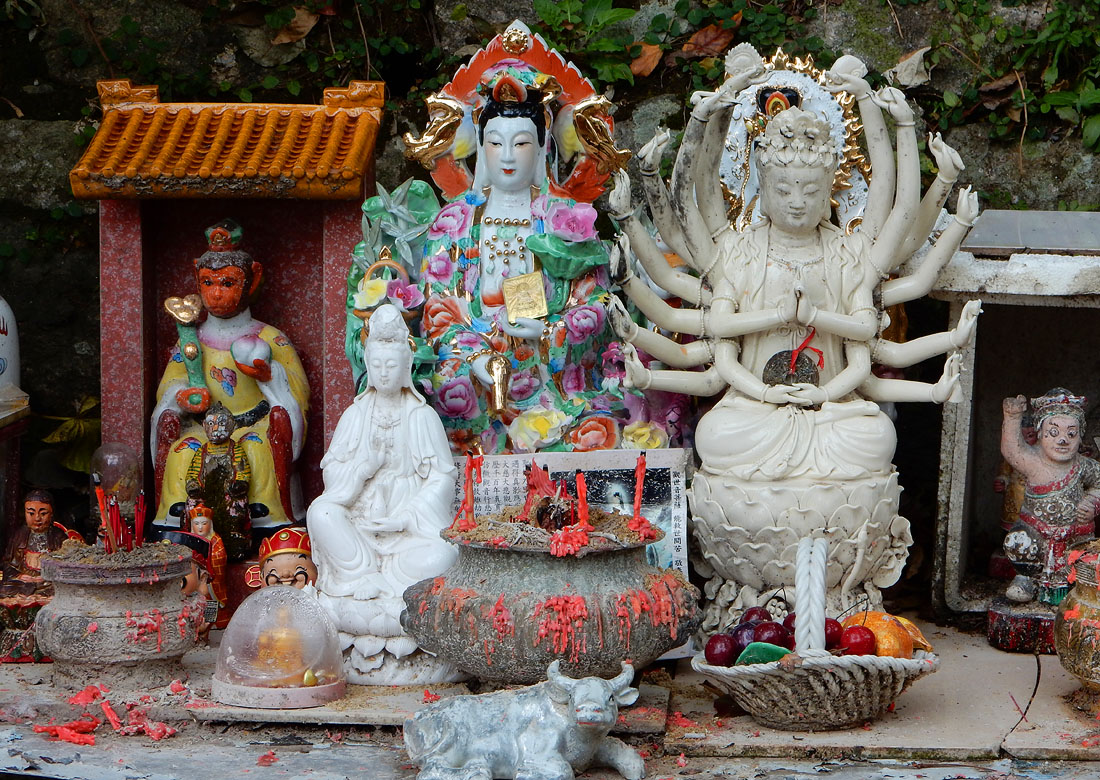 |
|||
| Detail of the local shrine. There is Monkey on the left. | |||
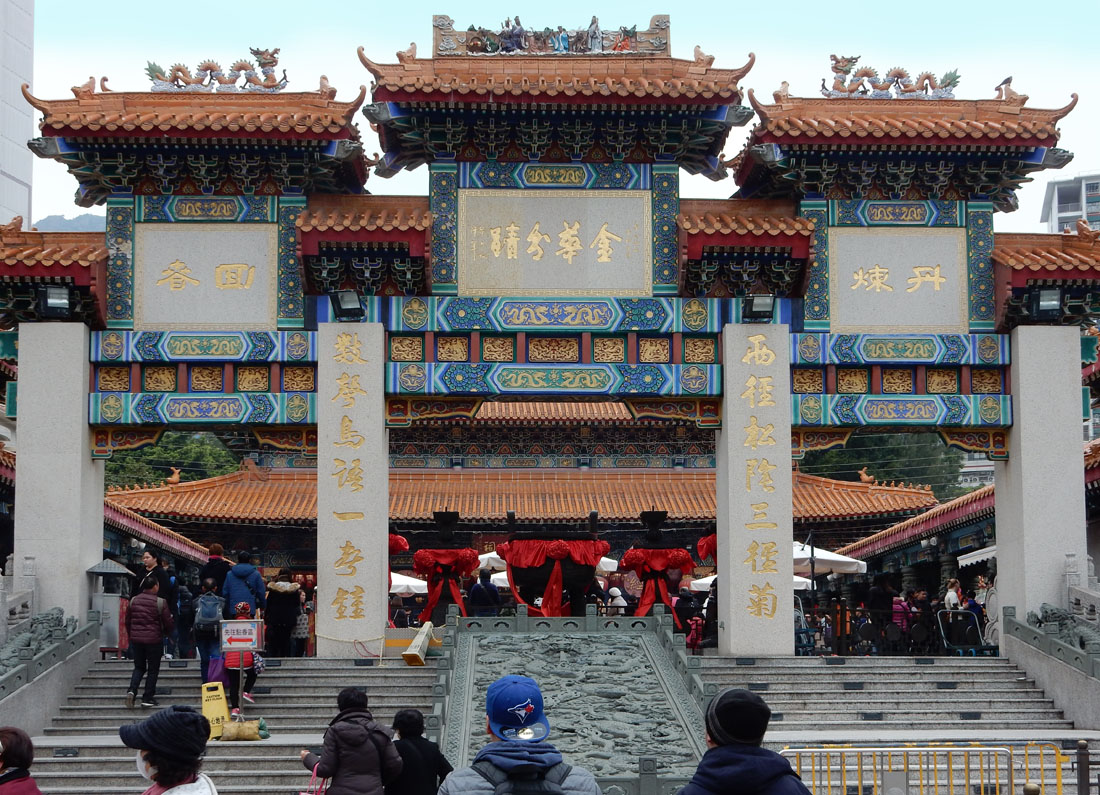 |
|||
| And now for something more impressive. This is the hugely popular Wong Tai Sin Temple in Kowloon. | |||
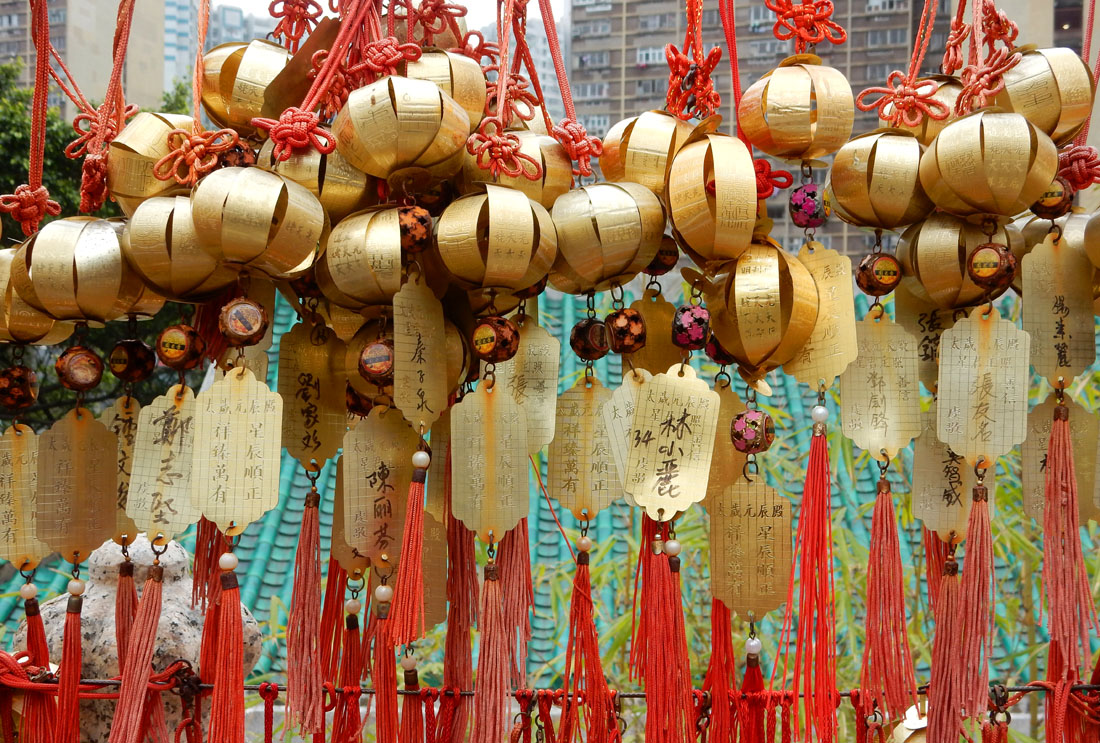 |
|||
| I think that these may be prayer messages from the worshippers at the Wong Tai Sin Temple. | |||
 |
|||
| Hong Kong is famous for its street markets, and most of you would have heard about the Ladies Market and the Temple Street Market in Kowloon. But street markets are to be found in all sorts of places in Hong Kong.
This one in Wanchai is on a street which in the day time is normally full of cars, but, at a certain time, the street is blocked off, stalls miraculously appear and... LIGHTS... CAMERA... STREET MARKET! |
|||
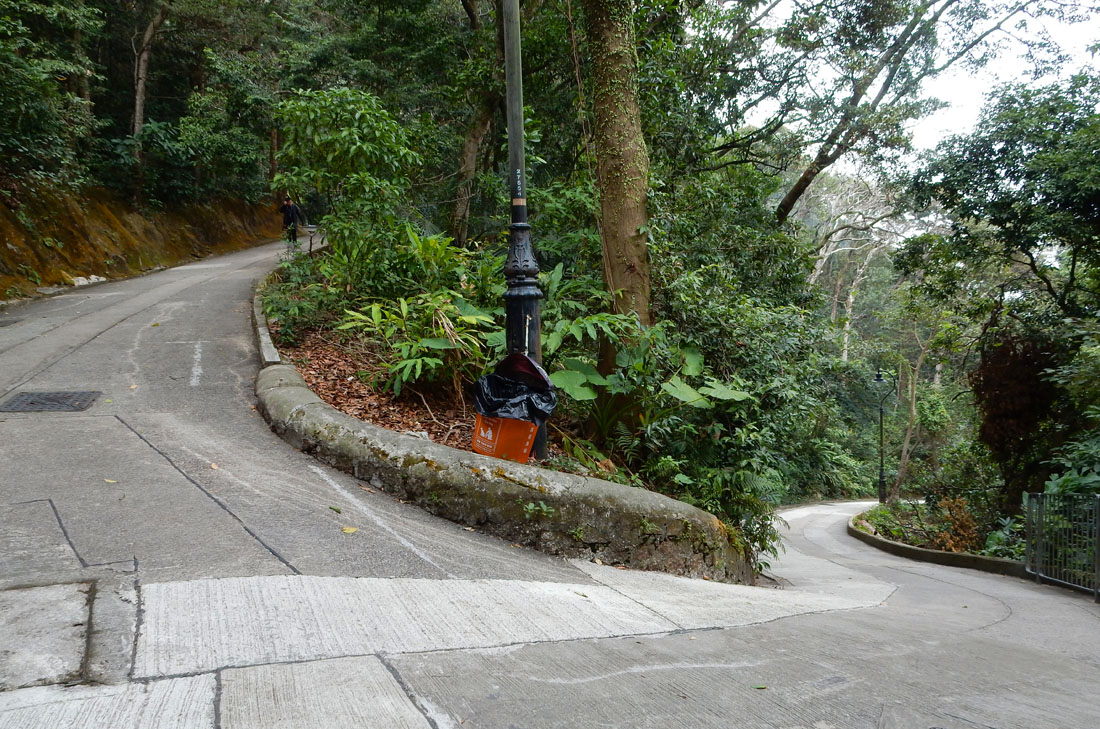 |
|||
| This is part of the Old Peak Road. Just imagine, before the Peak Tram was built, two man teams of sedan chair carriers would carry the privileged elite from the harbour to their cool residences on the Peak.
I can vouch for the steepness of this Old Peak Road as, during the War, when my father refused to work for the Japanese on principle, he would often go to Fanling in the New Territories, buy fresh vegetables for resale, and take them back in rattan suitcases to the Italian Convent on Caine Road (Mid Levels), where we lived. Then, my brother and I would help him put the vegies into an old pram that we found, and we would take turns pushing that laden pram up the Old Peak Road to the Peak. During the War, there were still a few Consulates of countries which were either neutral or were allies of the Japanese. I suspect that they were taking pity on us when they bought our vegetables. I was about 7 years old at that time. You gotta do strange things to survive. |
|||
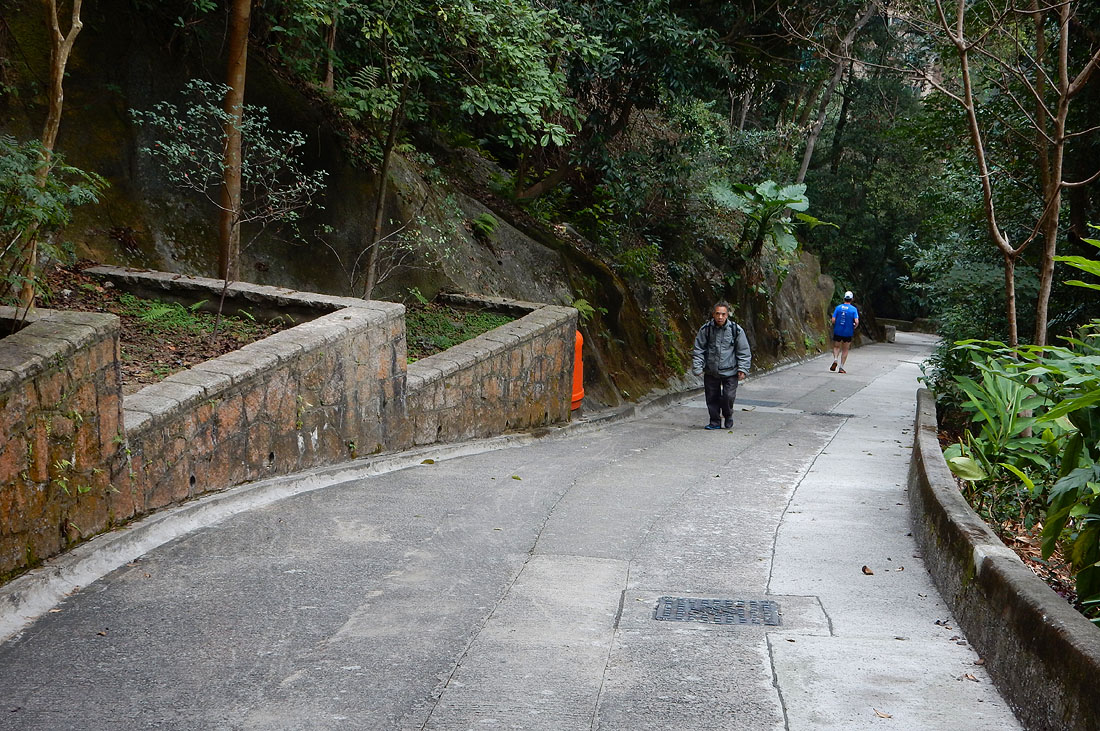 |
|||
| One more shot of the Old Peak Road. | |||
 |
|||
| I caught a mini ferry from Kwun Tong in Kowloon to Sai wan Ho on Hong Kong Island. On the way I had this view of the very end of the old Kai Tak Airport runway. It is now used as a Cruise Terminal. Kai Tak Airport had the reputation of being one of the scariest air strips upon which to land!
Long before this runway was built, my friend Alex Huber and I were asked by the Royal Air Force to form the nucleus of Hong Kong's first Air Scout Troop. We were stationed in the RAF section of the old Kai Tak Airport. Those were the days! |
|||
 |
|||
| I leave you with this shot of the pavilion and the beach at Repulse Bay. The ships on the horizon may well be waiting their turn to dock at the container terminal on Tsing Yi Island. | |||
|
To return to the Paintings section of this website, please CLICK HERE
|
|||